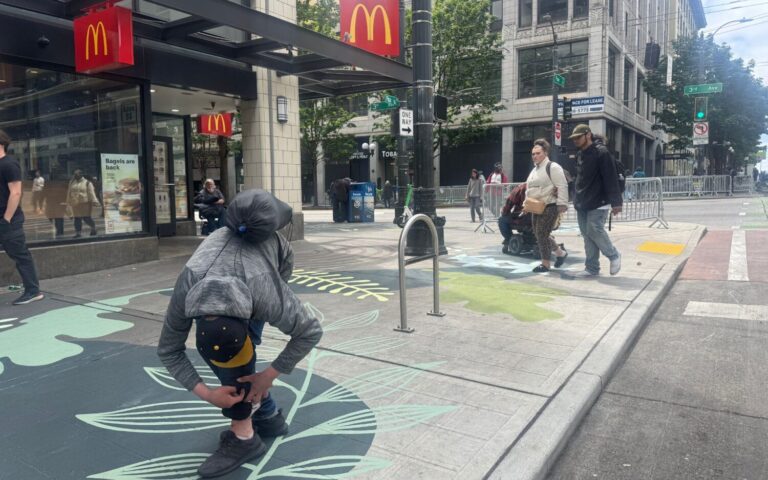As fentanyl addicts and the mentally ill continue to languish and die on our streets, Mayor Bruce Harrell’s administration has decided that what downtown Seattle really needs are sidewalk murals. Because nothing says “we’re tackling the root causes of homelessness” quite like ensuring that when a drug addict passes out, they do so on a vibrant, city-commissioned work of art.
The sidewalk murals are part of Harrell’s uninspired Downtown Activation Plan. One of the action steps? “Create more murals and other art installations throughout Downtown and activate street corners, parks, and transit stations with buskers and other forms of entertainment to create a more beautiful and welcoming environment, mitigating the impact of graffiti and street disorder.”
The logic, if you can call it that, seems to be that if we make the scenery prettier, the human suffering playing out against it will somehow be less tragic. It’s a continuation of the same tired, ineffective, and lazy approach we’ve seen countless times from our city’s leadership. Harrell is a master of the performative gesture, the symbolic act that accomplishes nothing but allows the mayor to pat himself on the back for a job well done.
This is not a parody. This is the actual strategy of a city in the throes of a humanitarian crisis.
As part of the plan to tackle downtown Seattle homelessness, the mayor is having murals painted on the sidewalks.
But all this means is that fentanyl addicts will pass out on murals. pic.twitter.com/8EC2KSUvyw
— Jason Rantz on KTTH Radio (@jasonrantz) June 26, 2025
Bruce Harrell’s homelessness plans? Sidewalk art and lighting
This sidewalk mural initiative is a perfect companion piece to another of the mayor’s recent beautification-as-solution projects: strings of lights a few blocks away from where the homeless congregate.
Billed as a way to “enhance community safety and vibrancy,” the decorative lights are meant to deter crime and make residents feel more secure. But ask anyone who lives or works in the downtown core and Belltown, and they’ll tell you that the problem isn’t a lack of ambient lighting. The problem is the open-air drug markets, the relentless property crime, and the sense that the city has all but abandoned them to the wolves.
The lights and sidewalk murals are a slap in the face to a community that has been begging for a real plan, for more police, and for a commitment to prosecuting the criminals who are making their lives a living hell.
Seattle residents should be insulted
What these initiatives share is a fundamental misunderstanding, or perhaps a willful ignorance, of the nature of the problem.
We are not dealing with a crisis of aesthetics. We are dealing with a crisis of addiction, of mental illness, and of a complete and utter breakdown of law and order. Painting a mural on a sidewalk will not get a fentanyl addict into treatment. Installing a light fixture will not stop a prolific offender from breaking into another small business.
These are solutions for a city that is not in crisis, for a city that has the luxury of worrying about its appearance. That is not Seattle.
We actually know what tackles homelessness
The tragic irony is that we know what works. We know that a compassionate, but firm approach, one that combines robust and readily available treatment options with a law enforcement presence that makes it clear that criminal behavior will not be tolerated, is the only way to make a real difference.
Seattle should be investing in long-term treatment facilities, in mental health care, and in a criminal justice system that is allowed to do its job. Instead, we get murals and mood lighting. Soon? Buskers.
It’s a tale of two cities. In the Seattle mayor’s press releases, the city is becoming more vibrant, more beautiful, and more welcoming with each passing day. In the real Seattle, the one that the rest of us have to live in, things are getting worse. The open-air drug use, the homeless encampments, the property crime—these are the realities that a fresh coat of paint and some light bulbs cannot hide.
The people of Seattle are not asking for a more scenic city. Our city is beautiful—when you clean up the mess made by the homeless.
Listen to The Jason Rantz Show on weekday afternoons from 3 p.m. – 7 p.m. on KTTH 770 AM (HD Radio 97.3 FM HD-Channel 3). Subscribe to the podcast here. Follow Jason Rantz on X, Instagram, YouTube, and Facebook.





